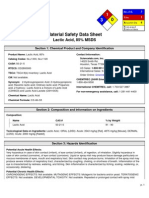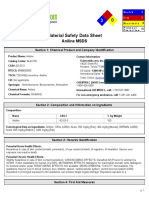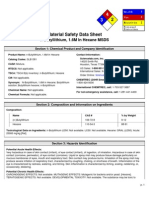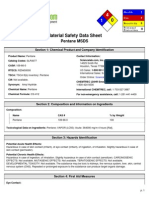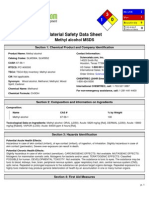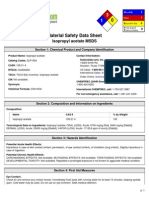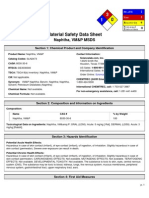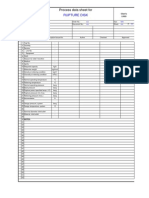Butyl Acrylate MSDS: Section 1: Chemical Product and Company Identification
Butyl Acrylate MSDS: Section 1: Chemical Product and Company Identification
Uploaded by
safaldCopyright:
Available Formats
Butyl Acrylate MSDS: Section 1: Chemical Product and Company Identification
Butyl Acrylate MSDS: Section 1: Chemical Product and Company Identification
Uploaded by
safaldOriginal Description:
Original Title
Copyright
Available Formats
Share this document
Did you find this document useful?
Is this content inappropriate?
Copyright:
Available Formats
Butyl Acrylate MSDS: Section 1: Chemical Product and Company Identification
Butyl Acrylate MSDS: Section 1: Chemical Product and Company Identification
Uploaded by
safaldCopyright:
Available Formats
p.
1
2
3
2
He a lt h
Fire
Re a c t iv it y
Pe rs o na l
Pro t e c t io n
2
3
1
H
Material Safety Data Sheet
Butyl Acrylate MSDS
Section 1: Chemical Product and Company Identification
Product Name: Butyl Acrylate
Catalog Codes: SLB1666
CAS#: 141-32-2
RTECS: UD3150000
TSCA: TSCA 8(b) inventory: Butyl Acrylate
CI#: Not available.
Synonym: Acrylic acid n-butyl ester; Acrylic acid, butyl
ester; Butyl-2-propenoate; n-Butyl acrylate
Chemical Name: 2-Propenoic acid, butyl ester
Chemical Formula: C7-H12-O2
Contact Information:
Sciencelab.com, Inc.
14025 Smith Rd.
Houston, Texas 77396
US Sales: 1-800-901-7247
International Sales: 1-281-441-4400
Order Online: ScienceLab.com
CHEMTREC (24HR Emergency Telephone), call:
1-800-424-9300
International CHEMTREC, call: 1-703-527-3887
For non-emergency assistance, call: 1-281-441-4400
Section 2: Composition and Information on Ingredients
Composition:
Name CAS # % by Weight
Butyl Acrylate 141-32-2 100
Toxicological Data on Ingredients: Butyl Acrylate: ORAL (LD50): Acute: 900 mg/kg [Rat]. 5880 mg/kg [Mouse]. DERMAL
(LD50): Acute: 1780 mg/kg [Rabbit]. VAPOR (LC50): Acute: 2730 ppm 4 hours [Rat]. 7800 mg/m 2 hours [Mouse].
Section 3: Hazards Identification
Potential Acute Health Effects:
Hazardous in case of skin contact (permeator), of eye contact (irritant), of ingestion, of inhalation (lung irritant). Slightly
hazardous in case of skin contact (irritant).
Potential Chronic Health Effects:
CARCINOGENIC EFFECTS: 3 (Not classifiable for human.) by IARC. MUTAGENIC EFFECTS: Not available. TERATOGENIC
EFFECTS: Not available. DEVELOPMENTAL TOXICITY: Not available. The substance may be toxic to kidneys, lungs, liver,
upper respiratory tract, skin, eyes. Repeated or prolonged exposure to the substance can produce target organs damage.
Section 4: First Aid Measures
Eye Contact:
p. 2
Check for and remove any contact lenses. In case of contact, immediately flush eyes with plenty of water for at least 15
minutes. Cold water may be used. WARM water MUST be used. Get medical attention.
Skin Contact:
In case of contact, immediately flush skin with plenty of water for at least 15 minutes while removing contaminated clothing
and shoes. Cover the irritated skin with an emollient. Wash clothing before reuse. Thoroughly clean shoes before reuse. Get
medical attention.
Serious Skin Contact:
Wash with a disinfectant soap and cover the contaminated skin with an anti-bacterial cream. Seek immediate medical
attention.
Inhalation:
If inhaled, remove to fresh air. If not breathing, give artificial respiration. If breathing is difficult, give oxygen. Get medical
attention.
Serious Inhalation:
Evacuate the victim to a safe area as soon as possible. Loosen tight clothing such as a collar, tie, belt or waistband. If
breathing is difficult, administer oxygen. If the victim is not breathing, perform mouth-to-mouth resuscitation. WARNING: It may
be hazardous to the person providing aid to give mouth-to-mouth resuscitation when the inhaled material is toxic, infectious or
corrosive. Seek medical attention.
Ingestion:
Do NOT induce vomiting unless directed to do so by medical personnel. Never give anything by mouth to an unconscious
person. If large quantities of this material are swallowed, call a physician immediately. Loosen tight clothing such as a collar,
tie, belt or waistband.
Serious Ingestion: Not available.
Section 5: Fire and Explosion Data
Flammability of the Product: Flammable.
Auto-Ignition Temperature: 279 C (534 F) - 292C (557.6F)
Flash Points: CLOSED CUP: 29C (84.2F) - 39 C(102.2 F). OPEN CUP: 47.778C (118F).
Flammable Limits: LOWER: 1.3% -1.7% UPPER: 9.4% - 9.9%
Products of Combustion: These products are carbon oxides (CO, CO2).
Fire Hazards in Presence of Various Substances:
Highly flammable in presence of open flames and sparks, of heat. Non-flammable in presence of shocks.
Explosion Hazards in Presence of Various Substances:
Risks of explosion of the product in presence of mechanical impact: Not available. Slightly explosive in presence of open
flames and sparks.
Fire Fighting Media and Instructions:
Flammable liquid, soluble or dispersed in water. SMALL FIRE: Use DRY chemical powder. LARGE FIRE: Use alcohol foam,
water spray or fog. Cool containing vessels with water jet in order to prevent pressure build-up, autoignition or explosion.
Special Remarks on Fire Hazards: Vapor may travel considerable distance to source of ignition and flash back.
Special Remarks on Explosion Hazards: Vapors may form explosive mixtures with air.
Section 6: Accidental Release Measures
Small Spill: Absorb with an inert material and put the spilled material in an appropriate waste disposal.
Large Spill:
Flammable liquid. Keep away from heat. Keep away from sources of ignition. Stop leak if without risk. Absorb with DRY earth,
sand or other non-combustible material. Do not touch spilled material. Prevent entry into sewers, basements or confined
areas; dike if needed.
p. 3
Section 7: Handling and Storage
Precautions:
Keep away from heat. Keep away from sources of ignition. Keep away from direct sunlight or strong incandescent light.
Ground all equipment containing material. Do not ingest. Do not breathe gas/fumes/ vapor/spray. Avoid shock and friction.
Wear suitable protective clothing. In case of insufficient ventilation, wear suitable respiratory equipment. If ingested,
seek medical advice immediately and show the container or the label. Avoid contact with skin and eyes. Keep away from
incompatibles such as oxidizing agents, acids, alkalis.
Storage:
Store in a segregated and approved area. Keep container in a cool, well-ventilated area. Keep container tightly closed and
sealed until ready for use. Avoid all possible sources of ignition (spark or flame). Sensitive to light. Store in light-resistant
containers.
Section 8: Exposure Controls/Personal Protection
Engineering Controls:
Provide exhaust ventilation or other engineering controls to keep the airborne concentrations of vapors below their respective
threshold limit value. Ensure that eyewash stations and safety showers are proximal to the work-station location.
Personal Protection:
Splash goggles. Lab coat. Vapor respirator. Be sure to use an approved/certified respirator or equivalent. Gloves.
Personal Protection in Case of a Large Spill:
Splash goggles. Full suit. Vapor respirator. Boots. Gloves. A self contained breathing apparatus should be used to avoid
inhalation of the product. Suggested protective clothing might not be sufficient; consult a specialist BEFORE handling this
product.
Exposure Limits: Not available.
Section 9: Physical and Chemical Properties
Physical state and appearance: Liquid.
Odor: Fruity. Sharp, fragrant (Strong.)
Taste: Not available.
Molecular Weight: 128.17 g/mole
Color: Clear Colorless.
pH (1% soln/water): Not available.
Boiling Point: 145C (293F)
Melting Point: -64.6 (-84.3F)
Critical Temperature: 321C (609.8F)
Specific Gravity: 0.8898 (Water = 1)
Vapor Pressure: 0.5 kPa (@ 20C)
Vapor Density: Not available.
Volatility: Not available.
Odor Threshold: Not available.
Water/Oil Dist. Coeff.: The product is more soluble in oil; log(oil/water) = 2.4
Ionicity (in Water): Not available.
p. 4
Dispersion Properties: See solubility in water, diethyl ether, acetone.
Solubility:
Soluble in diethyl ether, acetone. Very slightly soluble in cold water. Practically insoluble in water. Solubility in Water: 0.14
g/100 ml water @ 20 deg. C.; 0.12 g/100 ml water @ 40 deg. C; 2,000 mg/l water @ 23 deg. C
Section 10: Stability and Reactivity Data
Stability:
The product is stable since it is stabilized or inhibited with Hydroquinone monomethyl ether (MEHQ). However, it may undergo
explosive polymerization if unhibited. It may polymerize on exposure to light. Polymerization may occur upon heating. It is
stable only if stored and handled under recommended conditions. The stability of the product depends upon the availability
of both dissolved oxygen and MEHQ. inhibitor. The presence of oxygen is necessary for the MEHQ to function effectively.
The product should never be stored under an inert gas atmosphere, but it should always be stored under an atmosphere
containing 5-21% oxygen by volume. Also, temperatures must be kept low to minimize formation of peroxides and other
products. This material is a monomer and may polymerize under certain conditions if the stabilizer/inhibitor is lost. Again,
hazardous polymerization may be caused elevated temperature, oxidizers, peroxides, or sunlight.
Instability Temperature: Not available.
Conditions of Instability: Heat, ignition sources, incompatible materials, light.
Incompatibility with various substances:
Reactive with oxidizing agents, acids, alkalis. The product may undergo hazardous decomposition, condensation or
polymerization.
Corrosivity: Not available.
Special Remarks on Reactivity: Incompatible with amines, halogens, peroxides. Sensitive to light.
Special Remarks on Corrosivity: Not available.
Polymerization: Yes, it may occur under certain conditions. Read special remarks under the section titled "Stability."
Section 11: Toxicological Information
Routes of Entry: Absorbed through skin. Dermal contact. Eye contact. Inhalation. Ingestion.
Toxicity to Animals:
Acute oral toxicity (LD50): 900 mg/kg [Rat]. Acute dermal toxicity (LD50): 1780 mg/kg [Rabbit]. Acute toxicity of the vapor
(LC50): 7800 mg/m 2 hours [Mouse]. 3
Chronic Effects on Humans:
CARCINOGENIC EFFECTS: 3 (Not classifiable for human.) by IARC. May cause damage to the following organs: kidneys,
lungs, liver, upper respiratory tract, skin, eyes.
Other Toxic Effects on Humans:
Hazardous in case of skin contact (sensitizer, permeator), of ingestion, of inhalation (lung irritant). Slightly hazardous in case
of skin contact (irritant).
Special Remarks on Toxicity to Animals:
Lethal Dose/Conc 50% Kill: LD50 [Rabbit] - Route: Skin; Dose: 2 ml/kg
Special Remarks on Chronic Effects on Humans: May cause adverse reproductive effects based on animal test data
Special Remarks on other Toxic Effects on Humans:
Acute Potential Health Effects: Causes skin irritation. It can be absorbed through the skin. It may be harmful if absorbed
through the skin. Eyes: Causes eye irritation. Inhalation: It causes respiratory tract (nose, throat) irritation causing coughing
and wheezing. Inhalation may affect respiration (dyspnea, pulmonary edema, suffocation). Very high exposures may
damage the lungs. It may also cause central nervous system effects such as headache, nausea, drowsiness, dizziness,
CNS depression. Ingestion: It causes gastrointestinal tract irritation with nausea, vomiting, and diarrhea. It may be harmful
p. 5
of swallowed. It may affect respiration (respiratory stimulation), and behavior/central nervous system(convulsions, and other
symptoms similar to inhalation) Chronic Potential Health Effects: Prolonged or repeated inhalation or ingestion may affect the
liver, kidneys. It may also affect behavior/central nervous system(drowsiness, changes in memory, concentration, or sleeping
patterns, and mood(especially irritability and social withdrawl), as well as fatigue and headaches), peripherial and autonomic
nervous systems. Prolonged inhalation may affect metabolism (weight loss). Very high exposures may result in pulmonary
congestion or damage the lungs. Prolonged or repeated skin contact may cause sensistization an allergic reaction.
Section 12: Ecological Information
Ecotoxicity: Not available.
BOD5 and COD: Not available.
Products of Biodegradation:
Possibly hazardous short term degradation products are not likely. However, long term degradation products may arise.
Toxicity of the Products of Biodegradation: The products of degradation are less toxic than the product itself.
Special Remarks on the Products of Biodegradation: Not available.
Section 13: Disposal Considerations
Waste Disposal:
Waste must be disposed of in accordance with federal, state and local environmental control regulations.
Section 14: Transport Information
DOT Classification: CLASS 3: Flammable liquid.
Identification: : Butyl Acrylate, stabilized UNNA: 2348 PG: III
Special Provisions for Transport: Not available.
Section 15: Other Regulatory Information
Federal and State Regulations:
Illinois toxic substances disclosure to employee act: Butyl Acrylate Rhode Island RTK hazardous substances: Butyl Acrylate
Pennsylvania RTK: Butyl Acrylate Minnesota: Butyl Acrylate Massachusetts RTK: Butyl Acrylate Massachusetts spill list: Butyl
Acrylate New Jersey: Butyl Acrylate New Jersey spill list: Butyl Acrylate California Director's List of Hazardous Substances:
Butyl Acrylate TSCA 8(b) inventory: Butyl Acrylate SARA 313 toxic chemical notification and release reporting: Butyl Acrylate
Other Regulations:
OSHA: Hazardous by definition of Hazard Communication Standard (29 CFR 1910.1200). EINECS: This product is on the
European Inventory of Existing Commercial Chemical Substances.
Other Classifications:
WHMIS (Canada):
CLASS B-3: Combustible liquid with a flash point between 37.8C (100F) and 93.3C (200F). CLASS D-1A: Material causing
immediate and serious toxic effects (VERY TOXIC). CLASS D-2B: Material causing other toxic effects (TOXIC). CLASS F:
Dangerously reactive material.
DSCL (EEC):
HMIS (U.S.A.):
Health Hazard: 2
Fire Hazard: 3
p. 6
Reactivity: 1
Personal Protection: h
National Fire Protection Association (U.S.A.):
Health: 3
Flammability: 2
Reactivity: 2
Specific hazard:
Protective Equipment:
Gloves. Lab coat. Vapor respirator. Be sure to use an approved/certified respirator or equivalent. Wear appropriate respirator
when ventilation is inadequate. Splash goggles.
Section 16: Other Information
References: Not available.
Other Special Considerations: Not available.
Created: 10/09/2005 04:27 PM
Last Updated: 05/21/2013 12:00 PM
The information above is believed to be accurate and represents the best information currently available to us. However, we
make no warranty of merchantability or any other warranty, express or implied, with respect to such information, and we assume
no liability resulting from its use. Users should make their own investigations to determine the suitability of the information for
their particular purposes. In no event shall ScienceLab.com be liable for any claims, losses, or damages of any third party or for
lost profits or any special, indirect, incidental, consequential or exemplary damages, howsoever arising, even if ScienceLab.com
has been advised of the possibility of such damages.
You might also like
- Improvised Munitions Handbook – Learn How to Make Explosive Devices & Weapons from Scratch (Warfare Skills Series): Illustrated & With Clear InstructionsFrom EverandImprovised Munitions Handbook – Learn How to Make Explosive Devices & Weapons from Scratch (Warfare Skills Series): Illustrated & With Clear InstructionsRating: 3.5 out of 5 stars3.5/5 (7)
- Agitator DesignDocument7 pagesAgitator DesignTint Tiger100% (4)
- Steam Tracing CalculationDocument44 pagesSteam Tracing CalculationsafaldNo ratings yet
- ATI PAO-4 Safety Data Sheet Section 1 - Chemical Product and Company InformationDocument6 pagesATI PAO-4 Safety Data Sheet Section 1 - Chemical Product and Company InformationApoloTrevinoNo ratings yet
- Foe Sample QuistionSDocument21 pagesFoe Sample QuistionSdudz80% (10)
- Unit-I Aircraft Systems (Hydraulic System)Document70 pagesUnit-I Aircraft Systems (Hydraulic System)Ram Kumar100% (1)
- Asam Oksalat (C2H2O4)Document6 pagesAsam Oksalat (C2H2O4)Dini HandayaniNo ratings yet
- MEADocument6 pagesMEAGhifaris VashaNo ratings yet
- MsdsDocument6 pagesMsdsRoby SuheriNo ratings yet
- Metil AcrilatoDocument6 pagesMetil Acrilatosoulwizard00No ratings yet
- Msds PentaneDocument6 pagesMsds PentaneMuhammad FikriansyahNo ratings yet
- Msds of GlycidolDocument6 pagesMsds of GlycidolDinesh TanwarNo ratings yet
- Material Safety Data Sheet 2,2,4-Trimethylpentane MSDSDocument6 pagesMaterial Safety Data Sheet 2,2,4-Trimethylpentane MSDSBilly T HoNo ratings yet
- MsdsDocument6 pagesMsdsKevin EsmunaldoNo ratings yet
- Msds Benzena PDFDocument6 pagesMsds Benzena PDFIrianto Rizaldi FaturrahmanNo ratings yet
- Acrylic Acid MSDS: Section 1: Chemical Product and Company IdentificationDocument6 pagesAcrylic Acid MSDS: Section 1: Chemical Product and Company Identificationzaaba100% (1)
- MsdsDocument6 pagesMsdsrashidalghifaryNo ratings yet
- Msds CresolDocument6 pagesMsds CresolArya Bima Aji KusumaNo ratings yet
- Msds Dietil EterijijDocument6 pagesMsds Dietil EterijijPriyosetyokoNo ratings yet
- Lactic Acid MsdsDocument6 pagesLactic Acid MsdsBlue Ofo-ob TJNo ratings yet
- MSDS - AnilinDocument6 pagesMSDS - AnilinsaririskihasibuanNo ratings yet
- L-Nicotine MSDSDocument6 pagesL-Nicotine MSDSagent4881No ratings yet
- Sodium Ethoxide MSDS: Section 1: Chemical Product and Company IdentificationDocument6 pagesSodium Ethoxide MSDS: Section 1: Chemical Product and Company IdentificationJosé Martín Meza CabillasNo ratings yet
- Acrolein PDFDocument6 pagesAcrolein PDFzaedmohd50% (2)
- Amil AlkoholDocument6 pagesAmil AlkoholJ FadliNo ratings yet
- Material Safety Data Sheet - Hydrixylamine - Kesehatan LingKerDocument6 pagesMaterial Safety Data Sheet - Hydrixylamine - Kesehatan LingKerLaras Ayu HapsariNo ratings yet
- Msds Isoprop Alkohol PDFDocument6 pagesMsds Isoprop Alkohol PDFmbapioNo ratings yet
- Msds Kmno4Document6 pagesMsds Kmno4Gilang RamadhanNo ratings yet
- Bu-Li MSDSDocument6 pagesBu-Li MSDSPrakash VenkatesanNo ratings yet
- Msds PDFDocument6 pagesMsds PDFToni ChandraNo ratings yet
- Msds ACROLEINDocument6 pagesMsds ACROLEINAde HadyNo ratings yet
- Msds N PentaneDocument6 pagesMsds N Pentanenirmal_subudhiNo ratings yet
- Nitric Acid, 65% MSDS: Section 1: Chemical Product and Company IdentificationDocument6 pagesNitric Acid, 65% MSDS: Section 1: Chemical Product and Company IdentificationpulmonerNo ratings yet
- Phenolphthalein IndicatorDocument6 pagesPhenolphthalein IndicatorwindaratlinNo ratings yet
- MSDS Benzalkonium ChlorideDocument7 pagesMSDS Benzalkonium ChlorideMark Evan SalutinNo ratings yet
- Potassium Hydroxide. 0.5N (Alcoholic) MSDS: Section 1: Chemical Product and Company IdentificationDocument6 pagesPotassium Hydroxide. 0.5N (Alcoholic) MSDS: Section 1: Chemical Product and Company IdentificationibessemalinaNo ratings yet
- Maleic Anhydride MSDS: Section 1: Chemical Product and Company IdentificationDocument6 pagesMaleic Anhydride MSDS: Section 1: Chemical Product and Company IdentificationFábio BrancoNo ratings yet
- Msds Kloroform)Document6 pagesMsds Kloroform)Muhammad SaprizalNo ratings yet
- Msds MethanolDocument6 pagesMsds MethanolFedi Rahman TaraNo ratings yet
- Alcohol MetílicoDocument6 pagesAlcohol MetílicoelpaulobaqueroNo ratings yet
- Msds Titipan1Document5 pagesMsds Titipan1anitacahyaNo ratings yet
- MSDSDocument6 pagesMSDSAra HilisNo ratings yet
- Msds Asam OksalatDocument6 pagesMsds Asam OksalatMitchell SmithNo ratings yet
- Print PDFDocument6 pagesPrint PDFseptika5426No ratings yet
- Material Safety Data Sheet Nitric AcidDocument7 pagesMaterial Safety Data Sheet Nitric AcidtradeasiagroupNo ratings yet
- Isopropyl Alcohol, 70% MSDS: Section 1: Chemical Product and Company IdentificationDocument6 pagesIsopropyl Alcohol, 70% MSDS: Section 1: Chemical Product and Company IdentificationSitti Munawarah II100% (1)
- Mercuric Chloride MSDS: Section 1: Chemical Product and Company IdentificationDocument6 pagesMercuric Chloride MSDS: Section 1: Chemical Product and Company IdentificationFitria Wahyu KurniawatiNo ratings yet
- Msds PropanolDocument6 pagesMsds PropanolDasa HaryuwibawaNo ratings yet
- Ethyl Acetate MSDS: Section 1: Chemical Product and Company IdentificationDocument6 pagesEthyl Acetate MSDS: Section 1: Chemical Product and Company IdentificationZachery IngramNo ratings yet
- MsdsDocument6 pagesMsdsRizki Adwitiyo 'Dito'No ratings yet
- Potassium Hydroxide MSDS: Section 1: Chemical Product and Company IdentificationDocument6 pagesPotassium Hydroxide MSDS: Section 1: Chemical Product and Company IdentificationMaulidaKhusnulNo ratings yet
- 1,2 DichloroethaneDocument6 pages1,2 DichloroethanePara Redha Prima BahriNo ratings yet
- Indikator PPDocument6 pagesIndikator PPNadhil Eka PutraNo ratings yet
- Msds FenolDocument6 pagesMsds Fenolbenol1987No ratings yet
- After a Disaster - Information to Help You and Your Family RecoverFrom EverandAfter a Disaster - Information to Help You and Your Family RecoverNo ratings yet
- Workplace Vocabulary for Esl Students: With Exercises and TestsFrom EverandWorkplace Vocabulary for Esl Students: With Exercises and TestsNo ratings yet
- Slowing the March of Time Preserving and Protecting Items Of Historical SignificanceFrom EverandSlowing the March of Time Preserving and Protecting Items Of Historical SignificanceNo ratings yet
- Improvised Weapons & Munitions – U.S. Army Ultimate Handbook: How to Create Explosive Devices & Weapons from Available Materials: Propellants, Mines, Grenades, Mortars and Rockets, Small Arms Weapons and Ammunition, Fuses, Detonators and Delay MechanismsFrom EverandImprovised Weapons & Munitions – U.S. Army Ultimate Handbook: How to Create Explosive Devices & Weapons from Available Materials: Propellants, Mines, Grenades, Mortars and Rockets, Small Arms Weapons and Ammunition, Fuses, Detonators and Delay MechanismsRating: 4.5 out of 5 stars4.5/5 (5)
- Allergy Relief: How to Completely Cure Allergies and Feel Free Using Natural Remedies (Get Rid of Allergies for Good Natural Medical and Lifestyle Solutions My Secret Solutions for All Your Private Problems)From EverandAllergy Relief: How to Completely Cure Allergies and Feel Free Using Natural Remedies (Get Rid of Allergies for Good Natural Medical and Lifestyle Solutions My Secret Solutions for All Your Private Problems)No ratings yet
- Georgia Pest Management Handbook: 2021 Home and Garden EditionFrom EverandGeorgia Pest Management Handbook: 2021 Home and Garden EditionEmily CabreraNo ratings yet
- Restrictive Orifice Calc For Tube FinalDocument12 pagesRestrictive Orifice Calc For Tube FinalsafaldNo ratings yet
- 4 GEN 8602 DOC - Vendor's Documentation RequirementsDocument7 pages4 GEN 8602 DOC - Vendor's Documentation RequirementssafaldNo ratings yet
- Receipt - Nusatrip Online TravelDocument1 pageReceipt - Nusatrip Online TravelsafaldNo ratings yet
- Vendors Info (2015!04!09) SsssssDocument49 pagesVendors Info (2015!04!09) SssssssafaldNo ratings yet
- 3182xxx - PDS For Rupture DiskDocument2 pages3182xxx - PDS For Rupture DisksafaldNo ratings yet
- Process Data Sheet For Tank / Vessel: XXX XXX XXX XXX XXX XXXDocument2 pagesProcess Data Sheet For Tank / Vessel: XXX XXX XXX XXX XXX XXXsafaldNo ratings yet
- Process Data Sheet For Temperature Gauge: XXX XXX XXX XXX XX of XXDocument2 pagesProcess Data Sheet For Temperature Gauge: XXX XXX XXX XXX XX of XXsafaldNo ratings yet
- Pressure Control Valve (PV) : Process Data Sheet ForDocument1 pagePressure Control Valve (PV) : Process Data Sheet ForsafaldNo ratings yet
- Design of AgitatorDocument3 pagesDesign of AgitatorManish PatelNo ratings yet
- 3181xxx - PDS For Mixer - AgitatorDocument1 page3181xxx - PDS For Mixer - AgitatorsafaldNo ratings yet
- PHA by Chemical Emergency Prevention and PlanningDocument10 pagesPHA by Chemical Emergency Prevention and PlanningCamilo RomeroNo ratings yet
- 3182xxx - Level Switch, Transmitter, IndicatorDocument4 pages3182xxx - Level Switch, Transmitter, IndicatorsafaldNo ratings yet
- 2011-08 Newsletter TNBVDocument3 pages2011-08 Newsletter TNBVsafaldNo ratings yet
- 8.62 Bars 45.6 C 8.62 Bars: Condenser Expansion CompressorDocument16 pages8.62 Bars 45.6 C 8.62 Bars: Condenser Expansion Compressorduazo2009100% (1)
- 3181xxx - PDS For FilterDocument1 page3181xxx - PDS For FiltersafaldNo ratings yet
- New Microsoft Excel WorksheetDocument6 pagesNew Microsoft Excel WorksheetsafaldNo ratings yet
- Pressure Vessel Nozzle Calc - ASME VIII Div 1Document20 pagesPressure Vessel Nozzle Calc - ASME VIII Div 1aauppal100% (1)
- Contact: Breweries in Race To Spur OutputDocument3 pagesContact: Breweries in Race To Spur OutputsafaldNo ratings yet
- Checklist With Checkpoints For Diagrams: Title BlockDocument6 pagesChecklist With Checkpoints For Diagrams: Title BlocksafaldNo ratings yet
- Styrene Acrylic LatexDocument4 pagesStyrene Acrylic LatexsafaldNo ratings yet
- Centrifugal PumpDocument68 pagesCentrifugal Pumpsafald100% (2)
- Styrene Acrylic LatexDocument4 pagesStyrene Acrylic LatexsafaldNo ratings yet
- Acrylic MsdsDocument3 pagesAcrylic MsdssafaldNo ratings yet
- 2eha MSDSDocument5 pages2eha MSDSsafaldNo ratings yet
- MSDS 2022Document7 pagesMSDS 2022ebra ilajNo ratings yet
- Laboratory Safety ManualDocument70 pagesLaboratory Safety ManualMaria Chacón Carbajal100% (1)
- EEX 208.01 Classification of and Protection For Hazardous LocationsDocument33 pagesEEX 208.01 Classification of and Protection For Hazardous LocationsMo'tasem Serdaneh100% (1)
- EG307 - Fire Protection SystemsDocument18 pagesEG307 - Fire Protection SystemssophieNo ratings yet
- Shocks Oil - Comparison ReportDocument2 pagesShocks Oil - Comparison ReportRaja Sekaran SajjaNo ratings yet
- Practice Occupational Health and Safety Procedures: Definition of TermsDocument15 pagesPractice Occupational Health and Safety Procedures: Definition of Termsmico alilayaNo ratings yet
- Enggineering Chem Manual Sem I 2023-24Document29 pagesEnggineering Chem Manual Sem I 2023-24samirbramhadevgorad001No ratings yet
- Juntas Flanchadas, Empaques y PernosDocument8 pagesJuntas Flanchadas, Empaques y Pernosjuancparra20No ratings yet
- 20.Tn CTRL of Industrial Major Accident Hazard Rules 1994Document60 pages20.Tn CTRL of Industrial Major Accident Hazard Rules 1994MDParthibanNo ratings yet
- MSDS Eaa 5050Document9 pagesMSDS Eaa 5050kazem.sh66No ratings yet
- Oisd 117Document78 pagesOisd 117poojaupes67% (3)
- Materi Pertemuan Ke 6Document49 pagesMateri Pertemuan Ke 6Riska YudhistiaNo ratings yet
- MaintenanceDocument82 pagesMaintenanceRajNo ratings yet
- Material SafetyDocument8 pagesMaterial SafetyOtto OttoNo ratings yet
- MSDS Aldehid General: Toxicity DataDocument27 pagesMSDS Aldehid General: Toxicity DataHarliana Rahim100% (1)
- Safety Data Sheet: ETHANOL UndenaturedDocument7 pagesSafety Data Sheet: ETHANOL UndenaturedArief Rachman RamadaniNo ratings yet
- Hazardous Waste Management Rules 2016Document116 pagesHazardous Waste Management Rules 2016Ansal M100% (1)
- Dilution of Flammable Polar Solvents by Water For Safe DisposalDocument12 pagesDilution of Flammable Polar Solvents by Water For Safe Disposal1940LaSalleNo ratings yet
- Material: Safety Data SheetDocument6 pagesMaterial: Safety Data Sheetatzin benitezNo ratings yet
- Helizarin TOW Liq C - MSDSDocument12 pagesHelizarin TOW Liq C - MSDSVictorian Groups FaisalabadNo ratings yet
- Sae Ams2644h-2020Document3 pagesSae Ams2644h-2020Robert UrtadoNo ratings yet
- 158990.001 - Solvente N°3 MSDS - EXXONDocument14 pages158990.001 - Solvente N°3 MSDS - EXXONBryanMojalottMoroteNo ratings yet
- 08-Huile-Overview of Oil TypesDocument3 pages08-Huile-Overview of Oil TypesmvsscribdNo ratings yet
- Kuwait Fire Department - Codes and Regulations (English Version) - Part 4 Hazard Applied ConditionsDocument207 pagesKuwait Fire Department - Codes and Regulations (English Version) - Part 4 Hazard Applied Conditionsahmedbhit04No ratings yet
- HG20660 2000 EnglishDocument43 pagesHG20660 2000 EnglishMingxia TuNo ratings yet
- Sigma ThinnerDocument2 pagesSigma ThinnerAsela BollegalaNo ratings yet
- Foshan Tian Bao Li Silicone Engineering Technology Co., Ltd. Material Safety Data SheetDocument5 pagesFoshan Tian Bao Li Silicone Engineering Technology Co., Ltd. Material Safety Data SheetShahramNo ratings yet




















